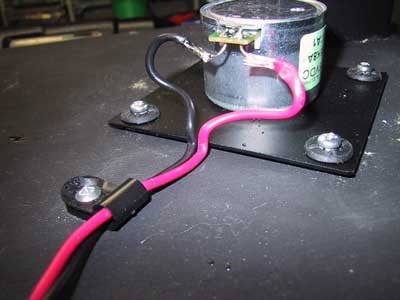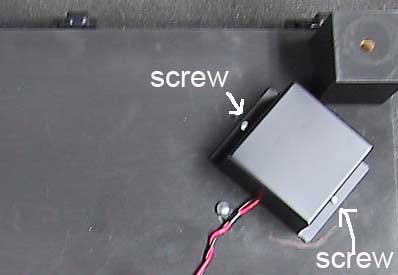
Notice how the wires are positioned. That is to avoid as little motor vibration as possible from transferring down the leads. However, the main point is the vibration dampeners (grommets in simple terms).
WHEN RECEIVED, THE MOTOR IS FOUND TO BE LOOSE
Your turntable was run for 24 hours with the supplied belt. Then, the
machine was calibrated for speed, and packed for shipping. So, something
occurred during shipping. This has occurred once and was probably due to
being severely shocked or dropped.
The motor pulley should not be rock solid in place; it will have some play. The motor is mounted
on a metal plate that has 4 pliable vibration dampeners on it. It should
be very slightly movable form side to side in all directions, but not very much.
Maybe 0.5 mm or 1/16 inch. The movement should be very slight. If it is
excessive, and it appears that the motor can also be pushed down more than 1 or
2 mm, about 1/4 inch, then it has become loose!
The motor is mounted to the base with 4 screws. The heads of these screws
to retain that assembly in place. If the machine is severely dropped,
the motor plate w/dampeners can pop over the mounting screws.

Notice how the wires are positioned. That is to avoid as little motor vibration
as possible from transferring down the leads. However, the main point is the
vibration dampeners (grommets in simple terms).
If you suspect that this could be the problem, you must take the motor cover off and inspect the motor mounting. The cover is held on by two screws.

To inspect the motor mounting, removed the two screws holding the cover down, and inspecting the motor. If it is loose, you can push it back into place.
The easiest way to accomplish this is to tip the turntable up from one side
to access the two cover screws, and take the cover off. Then push the
motor plate back into place and replace the cover.
If you want to turn the whole turntable over you should remove the main platter.
You could also remove the subplatter, wipe the brass flange clean with tissue,
and then put a piece of tape over the hole to prevent lubricant dripping.
However, you might just turn the machine over holding the subplatter in place
and setting the whole thing down on a surface of newspaper or old rags, both to
cushion it and catch anything that might drip, which is not likely.